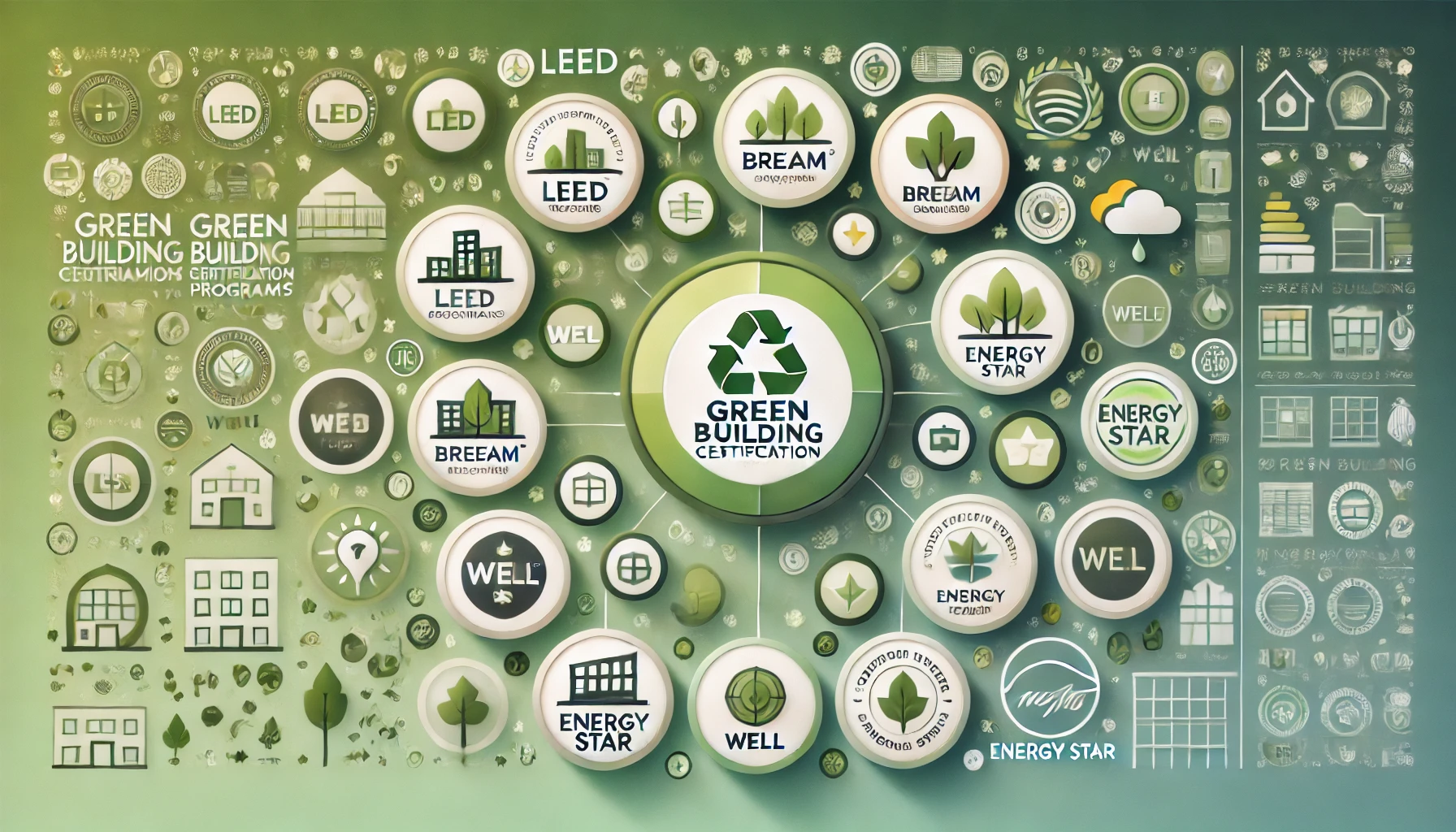In today’s world, where sustainability is no longer a choice but a necessity, green building certification programs have become increasingly important. These certifications not only ensure that buildings are environmentally friendly but also promote healthy living and working spaces. Among the most prominent certification programs are LEED (Leadership in Energy and Environmental Design) and BREEAM (Building Research Establishment Environmental Assessment Method). This article delves into these programs and others, providing a comprehensive guide to understanding their significance and benefits.
Understanding Green Building Certification Programs
Green building certification programs are systems that assess the environmental impact and sustainability of buildings. These programs evaluate various aspects such as energy efficiency, water usage, indoor environmental quality, and the materials used in construction. The goal is to minimize the environmental footprint of buildings while maximizing their efficiency and sustainability.
The Importance of Green Building Certifications
Green building certifications are crucial for several reasons:
- Environmental Protection: These certifications help reduce the negative impact of buildings on the environment by promoting sustainable practices.
- Health and Well-being: Certified buildings often provide better indoor air quality, natural lighting, and temperature control, enhancing the occupants’ health and comfort.
- Economic Benefits: Energy-efficient buildings lead to lower utility bills and maintenance costs, making them economically advantageous in the long run.
- Market Value: Certified buildings tend to have higher market value and attract environmentally conscious tenants and buyers.
LEED (Leadership in Energy and Environmental Design)
What is LEED?
LEED is one of the most widely recognized green building certification programs globally. Developed by the U.S. Green Building Council (USGBC), LEED provides a framework for healthy, highly efficient, and cost-saving green buildings. It is applicable to various types of projects, including residential, commercial, and institutional buildings.
LEED Certification Levels
LEED certification is awarded based on a points system. Projects earn points across several categories, such as sustainable sites, water efficiency, energy and atmosphere, materials and resources, and indoor environmental quality. Based on the total points achieved, projects can receive one of the following certification levels:
- LEED Certified: 40-49 points
- LEED Silver: 50-59 points
- LEED Gold: 60-79 points
- LEED Platinum: 80+ points
Benefits of LEED Certification
- Energy and Cost Savings: LEED-certified buildings use less energy and water, leading to significant cost savings over time.
- Healthier Environments: These buildings prioritize indoor air quality, natural lighting, and non-toxic materials, promoting a healthier environment for occupants.
- Reduced Carbon Footprint: By using sustainable materials and reducing energy consumption, LEED-certified buildings contribute to lower greenhouse gas emissions.
- Market Recognition: LEED is a globally recognized symbol of sustainability achievement, enhancing the reputation and marketability of certified buildings.
BREEAM (Building Research Establishment Environmental Assessment Method)
What is BREEAM?
BREEAM is a leading green building certification program developed in the United Kingdom by the Building Research Establishment (BRE). It assesses the environmental performance of buildings throughout their lifecycle, from design and construction to operation and refurbishment.
BREEAM Assessment Categories
BREEAM evaluates buildings based on a range of criteria, including:
- Management: Project management and commissioning processes.
- Health and Well-being: Indoor air quality, lighting, and thermal comfort.
- Energy: Energy efficiency and carbon emissions.
- Transport: Accessibility and transport options.
- Water: Water usage and efficiency.
- Materials: Sustainable sourcing and impact of construction materials.
- Waste: Waste management and recycling.
- Land Use and Ecology: Impact on local ecology and biodiversity.
- Pollution: Reduction of air, water, and noise pollution.
BREEAM Certification Ratings
BREEAM certification is awarded based on a points system, with ratings ranging from Pass to Outstanding:
- Pass: 30-45%
- Good: 45-55%
- Very Good: 55-70%
- Excellent: 70-85%
- Outstanding: 85%+
Benefits of BREEAM Certification
- Environmental Impact: BREEAM-certified buildings have a reduced impact on the environment through sustainable practices and efficient resource use.
- Occupant Well-being: These buildings prioritize the health and well-being of occupants by ensuring high standards of indoor environmental quality.
- Operational Savings: BREEAM-certified buildings often experience lower operational costs due to improved energy efficiency and resource management.
- Enhanced Marketability: Certification demonstrates a commitment to sustainability, increasing the building’s attractiveness to investors, tenants, and buyers.
Other Notable Green Building Certification Programs
While LEED and BREEAM are among the most prominent green building certification programs, there are several others worth mentioning:
Green Globes
Green Globes is a comprehensive, science-based building rating system that supports a wide range of sustainable design and operational practices. It is administered by the Green Building Initiative (GBI) in the United States and Canada. Green Globes assessments are conducted through a combination of self-evaluation and third-party verification.
WELL Building Standard
The WELL Building Standard focuses on the health and well-being of building occupants. It assesses buildings based on factors such as air, water, nourishment, light, fitness, comfort, and mind. WELL certification complements other green building certifications by addressing the human aspect of sustainability.
Living Building Challenge
The Living Building Challenge is one of the most rigorous green building certification programs. It encourages buildings to operate as cleanly, beautifully, and efficiently as nature’s architecture. Projects must meet strict performance criteria in categories such as site, water, energy, health, materials, equity, and beauty.
ENERGY STAR
While not a green building certification program per se, ENERGY STAR is a widely recognized symbol for energy efficiency. Administered by the U.S. Environmental Protection Agency (EPA), ENERGY STAR certifies buildings that meet strict energy performance standards.
Choosing the Right Certification Program
Selecting the appropriate green building certification program depends on several factors, including the type of project, location, and specific sustainability goals. Here are some considerations to help guide the decision:
- Project Scope: Determine the size and complexity of the project and whether it is new construction, renovation, or an existing building.
- Geographical Location: Some certification programs may be more relevant or recognized in certain regions.
- Sustainability Goals: Identify the primary sustainability objectives, such as energy efficiency, occupant health, or environmental impact.
- Budget and Resources: Consider the costs associated with certification and the availability of resources for meeting the program’s requirements.
When it comes to sustainable building practices, green building certification programs like LEED and BREEAM offer comprehensive frameworks that ensure environmental responsibility and efficiency. These certifications not only contribute to energy savings and lower operational costs but also enhance the health and well-being of occupants. By achieving certification, buildings can demonstrate their commitment to sustainability, gaining market recognition and attracting environmentally conscious tenants and buyers. In addition to LEED and BREEAM, programs like Green Globes, WELL Building Standard, and the Living Building Challenge provide tailored approaches to various aspects of sustainability, making it easier for projects to align with their specific goals.
Conclusion
Green building certification programs like LEED, BREEAM, and others play a pivotal role in promoting sustainable practices within the construction and real estate industries. By adhering to these standards, buildings can significantly reduce their environmental impact, enhance the well-being of occupants, and achieve economic benefits through improved efficiency and marketability. As the demand for sustainable buildings continues to grow, understanding these certification programs becomes increasingly important for developers, architects, and building owners committed to making a positive impact on the planet.
Whether you’re looking to certify a new construction project or improve the sustainability of an existing building, these programs offer valuable frameworks and guidance. Embracing green building certifications is not just a trend but a necessary step towards a more sustainable and resilient future.

